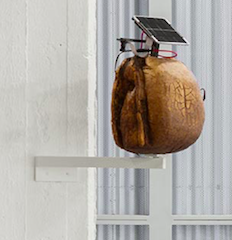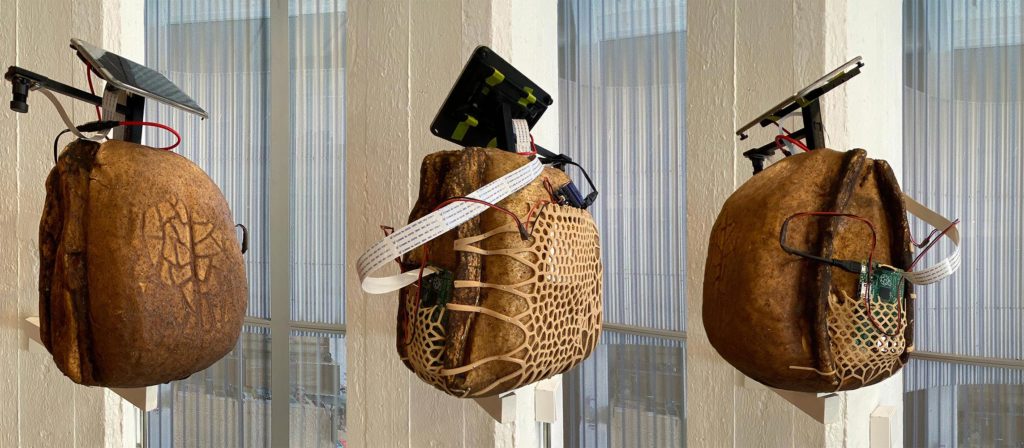The ‘Guerrilla Beehive’ is a sculpture & prototype resulting from a speculative research project. Conceived as a mobile shelter for swarming honeybees, it combines in a radical way smart materials, biomimetic forms and biotechnology. In a next iteration, the outer shell of the beehive will become a biosensor to monitor the health status of the environment. This research tackles a challenging domain where a collaboration between human and non-human actors is necessary to maintain the resilience of our ecosystem.
Colonies of colour-changing cyanobacteria will grow a dense biofilm on the outer shell of the Guerrilla Beehive. When the honeybees return to their nest after foraging, they land on the outer shell of the beehive with (possible) pollution- or pesticide particles in their fur, and they activate the bacteria in the biofilm. If the amount of pollution is trespassing a specific degree, the cyanobacteria in the biofilm will react by changing colour and as such give an alert.


‘Woven by Nature’ at iMAL; installation shot of ‘Guerrilla Beehive’, with on the background ‘Sea Garden I’.
©photos by Silvia Cappellari and AnneMarie Maes
De ‘Guerilla Beehive’ is een prototype resulterend uit een speculatief onderzoeksproject. Het wil een samenwerking tot stand brengen tussen menselijke en niet-menselijke actoren, deze samenwerking is noodzakelijk om de veerkracht van ons ecosysteem in stand te houden. De ‘Guerilla Beehive’ is opgevat als een mobiele schuilplaats voor zwermende honingbijen en combineert op een innovatieve manier slimme materialen, biomimetische vormen en biotechnologie. In de geplande volgende generatie van dit prototype zal de buitenste schil een biosensor worden om de ecologische toestand van de omgeving te observeren en visualiseren. Kolonies van kleurveranderende cyanobacteriën zullen dan een dichte biofilm vormen op de buitenste schil. Wanneer de honingbijen na het zoeken naar voedsel terugkeren naar hun nest, landen ze op deze schil met vervuilende fijn stof- of pesticidedeeltjes in hun vacht, en daardoor activeren ze de bacteriën in de biofilm. Als de hoeveelheid vervuiling een bepaalde grens overschrijdt, zullen de cyanobacteriën in de biofilm reageren door van kleur te veranderen en zo een alarmsignaal geven over de bedenkelijke staat van de omgeving.
‘The Guerrilla Beehive’ est le prototype d’un projet de recherche spéculative. Conçu comme un abri mobile pour les abeilles en essaim, il combine de manière radicale matériaux intelligents, formes biomimétiques et biotechnologie.
Dans le cadre de sa prochaine itération, l’enveloppe extérieure de la ruche deviendra un biocapteur qui surveille l’état de santé de l’environnement. Cette recherche s’attaque à un domaine exigeant où une collaboration entre l’humain et le non-humain est nécessaire pour maintenir la résilience de notre écosystème.
Des colonies de cyanobactéries aux couleurs changeantes formeront un biofilm dense sur l’enveloppe extérieure de la ruche ‘Guerrilla Beehive’. Lorsque les abeilles retournent au nid après avoir butiné, elles se posent sur l’enveloppe extérieure de la ruche. Les particules de pollution ou de pesticides présentes sur leur pelage activent alors les bactéries du biofilm. Si la concentration de pollution dépasse un certain seuil, les cyanobactéries du biofilm réagissent en changeant de couleur, et donnent ainsi l’alerte.


